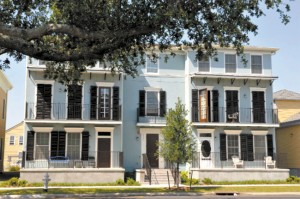Living along the Lafitte Greenway: Is it attainable or unaffordable?
29th September 2015 · 0 Comments
By Susan Buchanan
Contributing Writer
As post-Katrina housing prices have escalated, some residents have been forced out of their own neighborhoods. The city’s rents and home prices have more than doubled since 2000, according to HousingNOLA, a collaborative run by the Greater New Orleans Housing Alliance. Costs continue to rise as locals head for higher, less flood-prone ground, and gentrification is on a tear as out-of-towners settle here. Against that backdrop, residents wonder about the impact of the new Lafitte Greenway, a post-Katrina revitalization running from Armstrong Park to City Park, on housing and business leases.
The city had hoped to unveil the 2.6-mile, linear park last spring but that’s been delayed. “The greenway will open as soon as landscaping work, including grass and meadow plantings, is complete,” Bradley Howard, spokesman for Mayor Mitch Landrieu, said last week. In the meantime, pedestrians and bicyclists are using a paved path there.
Plenty of people want to stop the housing price-zoom. “The city, nonprofits and philanthropic groups are making a deliberate, intentional effort to keep rents and home prices near the greenway in check,” Andreanecia Morris, vice president for home ownership and community development at nonprofit Providence Community Housing, said last week. Her office is on South Jefferson Davis Parkway.
After gathering data and holding community forums, HousingNOLA plans to release an implementable, 10-year plan in November for the city, including areas around the greenway, Morris said. HousingNOLA issued an August 21 report assessing residential supply-and-demand factors in the last 10 to 15 years. Dwellings shrank in number because of Katrina damage, and the New Orleans City Council’s 2007 decision to tear down the down the Big Four housing projects didn’t help.
Meanwhile, the Landrieu administration has worked with stakeholders in conjunction with HousingNOLA’s upcoming plan to define affordable housing needs, Howard said. In recent years, the Housing Authority of New Orleans and area developers, along with federal agencies, created the Faubourg Lafitte complex and began to overhaul Iberville public housing to build mixed-income, mixed-use communities near the greenway, he said. The city helped craft a new Comprehensive Zoning Ordinance, approved by the City Council in May. And in early September, Mayor Landrieu signed into law an ordinance to amend the new CZO to spur construction of affordable residences, he said. Developers are now allowed to build denser, multi-family facilities as long as some of those units are for low-income tenants.
Hundreds of units have been built and leased at Faubourg Lafitte, the former Lafitte public housing bounded by Lafitte Street, Orleans Avenue, and N. Claiborne and N. Rocheblave Avenues. “Enterprise Community Partners, Providence Community Housing and L+M Development are redeveloping on and around the 27 acres of the former 900-unit Lafitte complex adjacent to the greenway,” Michelle Whetten, Gulf Coast vice president at Enterprise Community Partners, Inc., said last week. Enterprise is a housing group based in Maryland. “The Faubourg Lafitte development includes rental and for-sale homes that residents with a range of incomes can afford, and it prioritizes displaced former Lafitte residents for occupancy,” Whetten said. Leasing began in 2011.
Andreanecia Morris said that in addition to 276 subsidized units and 89 market rate units already built on site at Faubourg Lafitte, 126 subsidized rentals for seniors at St. Ann Apartments and St. Martin Manor are done, along with 57 rehabilitated historic and other rental units off site and 28 new, subsidized rentals off site. Completed off-site homes for sale include 16 rehabs and 75 that are newly constructed. To date, 667 units, including 576 rentals and 91 homes for sale are complete, Morris said.
When it’s finished, Faubourg Lafitte is slated to have 900 affordable apartments and 600 for-sale or market-rate rental homes, Whetten said. The project should be complete in 2017.
Developers want former Lafitte residents and others nearby to have access to quality, affordable, energy-efficient housing so that they don’t have to scrimp on necessities and services in education, heath care and transportation, Whetten said. Along with the greenway’s amenities, Faubourg Lafitte residents have access to jobs and services in the French Quarter and Mid-City, she noted. On Lafitte Avenue, the adjacent Sojourner Truth Neighborhood Center, which reopened in 2009 after Katrina damage and is operated by Providence, is a hub for Faubourg Lafitte residents and others, she said. The site has a Head Start center, a computer lab, playground and tennis courts.
Construction of the mostly federally-funded, Lafitte Senior Housing building began in January and should be finished by next May, Lesley Thomas, spokeswoman for the Housing Authority of New Orleans, said last week. The building is financed with $11.6 million in U.S. Dept. of Housing and Urban Development/HANO capital funds and $11 million from Federal Emergency Management Agency. Leasing begins in mid-2016. The Lafitte Senior building will contain a mix of public housing and HANO project-based, Housing Choice Voucher Program Section 8 units.
“Seniors applying for either type of these subsidized units will have to meet listed income requirements, along with the regular public-housing or Section 8 criteria,“ Thomas said. Incomes of senior, public-housing applicants can’t exceed 80 percent of the Area Median Income, or AMI , when a tenant’s eligibility is first screened, she said. The AMI for a family of four in New Orleans this year is $60,000. Incomes of senior, project-based, voucher applicants can’t exceed 50 percent of the AMI at the time of the tenant’s eligibility screening.
Meanwhile, more than 17,000 families of all ages citywide use HANO’s Housing Choice Voucher Program now, with another 20,000 families waiting listed.
Under the public-housing op-tion, Lafitte building seniors will have a choice of paying rent that’s equal to 30 percent of their monthly income, or paying public-housing, flat rents—set at 80 percent of the area’s Fair Market Rents established by HUD, Thomas said. Seniors who use project-based vouchers will pay 30 percent of their monthly income as rent.
The new Lafitte Senior building’s “payroll will be funded through rent collections and federal subsidies,” Thomas said. “Capital improvements will be funded through reserves using federal dollars, and will be replenished from rent collections and government subsidies.”
As for the former Iberville housing project, which dates to 1941, the estimated $600 million, new mixed-income and mixed-use Bienville Basin community there should revitalize the Iberville and Treme neighborhoods, according to the city. A chunk of its funding is from a $30.5 million, U.S. HUD Choice Neighborhoods Initiative grant, first allocated in 2011. In addition to federal sources; financing for Bienville Basin is a partnership between state and local authorities, banks and private-sector entities.
All 821 dwellings at Iberville will be replaced, with more added, for a total of 880. The community is slated for 304 public-housing units, another 261 units for families earning less than 60 percent of the Area Median Family income, and 315 market-rate units. Among the site’s amenities are fitness and computer centers, classrooms, community spaces and a public library. More than 300 city blocks, bounded by Rampart Street, Tulane Avenue, Broad Street and St. Bernard Avenue, should be invigorated, the city has said.
As for construction of Bienville’s 880 units, work under Phases I and II of the Iberville revamp began in 2013, and includes 227 apartments–81 public housing replacements, 53 “affordable” units and 93 market-rate units. one hundred new units are occupied now. Sixteen residential buildings were preserved at the site and are being renovated. Under the project’s Phase III, 105 mixed-income units and 4,000 square feet of retail space are being built now. So far, 53 families who were former Iberville residents have moved into or plan to occupy units built under Phases I and II. Another 70 former Iberville families hope to arrive during future phases of the development.
In addition to housing, the city and nonprofits have addressed some of the expected business issues near the greenway. Citywide, leases are rising in gentrified neighborhoods, pushing out local enterprises. Another, different issue is that grocers and others have shunned flood-prone and low-income areas. Bradley Howard said the city offers businesses, including those near the greenway, development incentives through a Small Business Assistance Fund and a Restoration Tax Abatement. The Industrial Board of the City of New Orleans runs pro-business programs, including PILOT, or Payment in Lieu of Taxes. Under PILOT, an enterprise in a target area can qualify to pay lower property taxes for a period.
Howard said grocery and food needs near the greenway have been addressed in part by the ReFresh project, funded by the city, banks, philanthropic groups, nonprofits and others. It opened last year on a formerly blighted site at North Broad and Bienville Streets, with a Whole Foods Market, a nonprofit Liberty’s Kitchen cafe, a teaching farm, Tulane University’s Goldring Center for Culinary Medicine and development-group Broad Community Connections.
As the city’s 300th anniversary in 2018 nears, the Landrieu administration is committed to smart growth and safe, vibrant neighborhoods, with affordable, quality housing and access to businesses and services, Howard said.
This article originally published in the September 28, 2015 print edition of The Louisiana Weekly newspaper.




